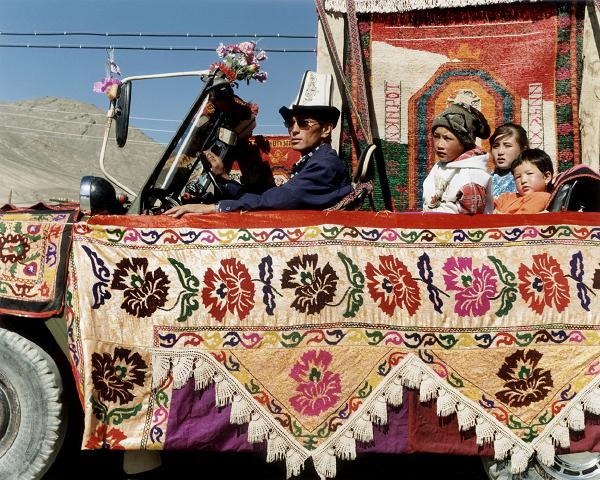
|
Rip Hopkins Tajikistan Weaving © Rip Hopkins, 2001 … Rip Hopkins' long stay in one of the republics of Central Asia that were part of the Soviet Union, whose name, wholly exotic, masks the fact that we live in perfect ignorance of the country itself (who could have located Tadjikistan on the globe before the war in Afghanistan showed it bordering on a country under the sway of the Taliban?), was not so much a journey as an attempt to bring a mystery into focus. Of course it was a journey in the sense that it involved travel to another destination, and in the sense that there was a compelling desire to make a journey, in every sense, through a country that is quite unknown. It was also a journey because he wished, as he explains so excellently, to go among people and meet them in their own cultural context – a culture centred on the craft of carpet-weaving. It was a journey, but one whose photographic record cannot be dismissed as a type of “notebook” of the kind that became popular following Bernard Plossu's Mexican Voyage, nor can it be described as an attempt to create an ethnological or ethnographical record, something we have seen re-emerging after losing ground since the thirties, when it gave way to travel photography, a genre which, first in black-and-white and then in colour, was – and often still is – created to grace the pages of magazines and albums, inviting us, in their own words, to “dream” and indulge in travel by proxy. The approach of Rip Hopkins is quite different. Essentially frontal and precisely framed, he records situations, captures moments and, above all, captures space. Seemingly artless, leaving one to wonder in the circumstances whether the persons photographed gave their consent and accepted the presence of someone capturing them on film, these pictures display a quiet determination, not just to reproduce the world he sees but to provide a record of situations that make personal sense to the traveller (which is their intimate dimension) and show proof of the wonderment he experiences when faced with ways of life that differ from those he knows in Europe. By breathing new life into an important tradition in photography, Rip Hopkins – and this is one of his particular merits – uses colour to give it new meaning. The ordinary format and the negative are used by him to confront a highly coloured world with a restraint, a finesse and a sense of composing through colour which are quite remarkable. No hankering after the spectacular, no flashy effects, no cheap mocking in situations where sometimes kitsch would seem to be the overriding element, no temptation to exploit voyeuristically the charm of the exotic. Simply a correctness of approach, generous, respectful, with carefully composed images that stress the interplay of colour and use the viewfinder to capture the unaffected poses of the persons he sees. For us who know no better and do not know the country, Tadjikistan becomes a place that questions light itself in its ability to invent this interplay of colour, and, strangely, too, a place where time calms the spirit, enhanced by soft-focus monochrome tints that at the same time allow the occasional flash of vivid colour to filter through. These are legends, precise, simple legends, that give us the information we need. … Christian Caujolle Back Next |